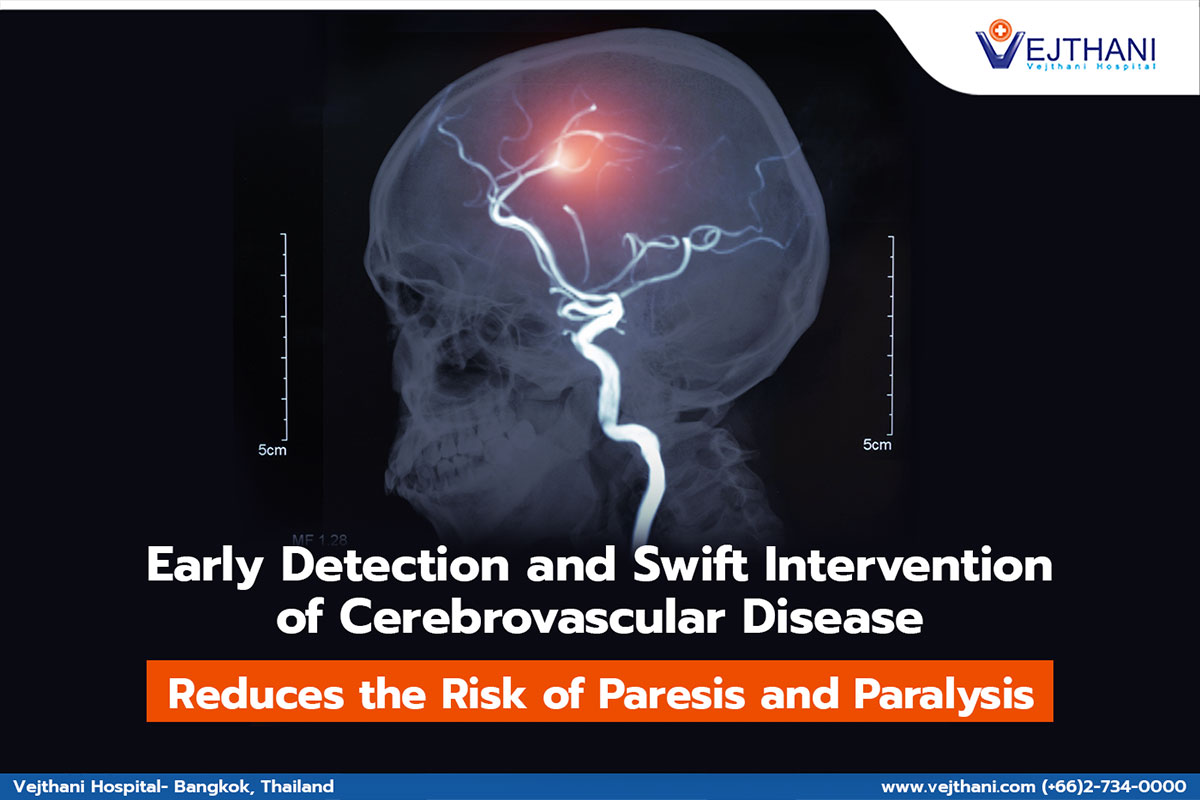

Cerebrovascular disease can occur in anyone. The severity of the disease can lead to paralysis, death, or other disabilities if it is not treated promptly.
Dr. Pongsakorn Pongsapas, neurosurgeon at Vejthani Hospital, explained that a blockage, narrowing, or rupture of a blood vessel in the brain causes stroke or cerebrovascular disease. This can cause injury or a lack of blood supply to the affected area of the brain, resulting in damaged brain cells. The symptoms that may follow include facial weakness that may cause drooping, slurred speech or inability to speak, blurred vision or double vision, weakness in the arms or legs, numbness on one side of the body, or unsteadiness. Stroke can occur in middle-aged and older adults, especially those with underlying medical conditions, as blood vessels tend to deteriorate with age and other factors.
2 Types of Cerebrovascular Diseases:
- Ischemic stroke occurs when there is a blockage in the blood vessels of the brain, which is caused by a buildup of plaque in the artery wall or by a blood clot that travels from the heart to the brain. These could disrupt blood flow to the brain, resulting in a sudden lack of oxygen and cell death.
- Hemorrhagic stroke occurs when a blood vessel in the brain ruptures. This can be caused by high blood pressure, which weakens the blood vessels, or by the degeneration of blood vessels, which makes them more fragile. When a blood vessel ruptures, it leads to bleeding in the brain and can eventually damage the brain tissue.
Underlying medical conditions, such as hypertension, diabetes, heart disease, high cholesterol, obesity, as well as smoking, and excessive alcohol consumption, are risk factors for cerebrovascular disease.
Cerebrovascular diseases are diagnosed by brain imaging diagnostic tests such as Computed Tomography (CT scan) or Magnetic Resonance Imaging (MRI). These methods provide detailed images of blood vessels and nerves, offering clearer visibility. Vejthani Hospital is equipped with the latest MRI machine operated by artificial intelligence that has a wider tunnel, reduced noise, and Free Breathing technology, ensuring a more comfortable experience for patients during the examination and swiftly diagnosing the disease.
Additionally, Transcranial Doppler (TCD) is used to assess blood flow to the brain, and Carotid Doppler is used to examine blood vessels in the neck. Accurate results from these tests can help doctors plan effective prevention and treatment strategies.
Prompt treatment is crucial for acute cerebrovascular disease to minimize brain cell damage. Swiftly restoring normal blood flow can accelerate the recovery of brain tissues, allowing patients to return to their everyday lives. In the early stage of symptoms, the doctor will assess the patient to find an indication for antiplatelet medication. If there are no contraindications, the doctor will administer antiplatelet medication within 4.5 hours. In cases where large brain blood vessels are obstructed, the doctor will treat by inserting a catheter into the femoral artery or into the wrist up to the cerebral artery to remove the clot in the artery. The procedure is Mechanical thrombectomy, a rapid treatment that significantly reduces brain injury and yields favorable outcomes in brain function.
Currently, the Hybrid Operating Room plays an essential role in swiftly and precisely addressing cerebrovascular disease. This cutting-edge facility integrates advanced medical equipment, including angiography machines, computer navigation systems, and endoscopic surgical tools.
At the heart of this transformative technology lies Biplane Digital Subtraction Angiography (Biplane DSA), a two-plane diagnostic and therapeutic X-ray technique. With remarkable precision, Biplane DSA captures simultaneous images of blood vessels in anterior and lateral planes. The resulting high-resolution images allow doctors to clearly visualize even the tiniest catheters, which is equivalent to seeing a 3D image. Biplane DSA also facilitates accurate measurement, calculation, and evaluate the location of vascular abnormalities. This sophisticated technology minimizes the contrast agent required, shortens treatment duration, and significantly lowers the risk of complications.
Biplane DSA allows doctors to insert small catheters into targeted locations swiftly and precisely. For instance, in patients with blood clots in the brain, doctors can insert a catheter into the clot-affected area and administer a small amount of antiplatelet medication directly to dissolve the clot. Specialized tools will remove the larger blood clots from the obstruction, restoring normal blood flow to the brain.
The following are the preventive measures for cerebrovascular diseases, which can cause narrowing, blockage, or rupture of blood vessels.
- Avoid foods high in cholesterol and saturated fat
- Quit smoking
- Effective management of diabetes and hypertension
- Maintain a healthy weight
- Reduce alcohol consumption
- Regular exercise
It is essential to observe your symptoms and your loved ones. If you experience any symptoms that may be indicative of cerebrovascular disease, seek medical attention immediately. Early treatment can increase the chances of restoring normal brain function and minimize the risk of paresis or paralysis.
For more information, please contact
Neuroscience Center, Vejthani Hospital.
Tel. 02-734-0000 Ext. 5400
English Hotline: (+66)8-522 38888
- Readers Rating
- Rated 5 stars
5 / 5 ( Reviewers) - Spectacular
- Your Rating

























